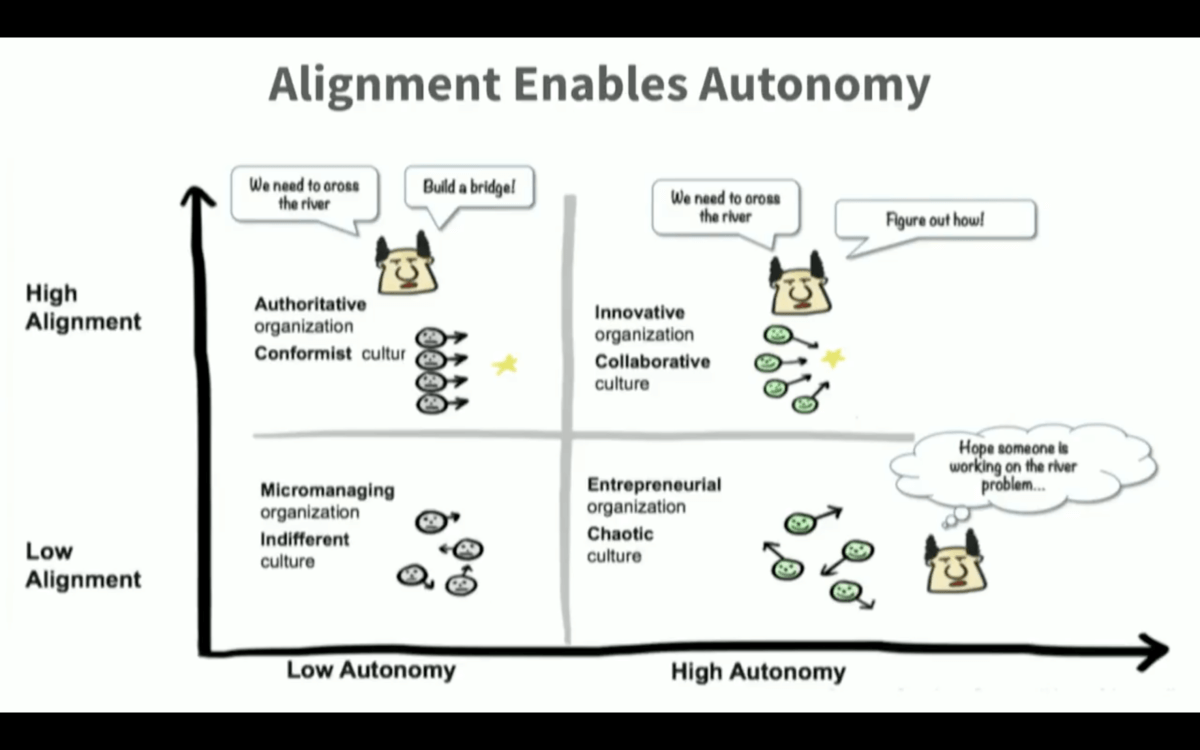Product teams are driven by understanding and experiencing customer pain, and building products to ease and remove that pain. They know and understand the customer better than anyone in the organization. Unfortunately, as companies scale, product teams often find themselves navigating through a new maze of process, increasing frustration and limiting productivity.
Earlier this month, I had the chance to attend a thought-provoking talk from Nate Barrett at the Front conference in Salt Lake City. Nate spoke passionately about building a company and team culture of autonomy and alignment to combat some of the inefficiencies and challenges that process presents. Nate is the VP of Product and Design and Canopy, a software product that changes the way accountants manage their tax practice.
His talk focused on the challenge of maintaining velocity while building a culture of freedom, teamwork, and innovation.
Why Autonomy?
In short, building an autonomous team is vital because freedom is motivating, and motivated people build better products. In an autonomous environment, the operating principle is trust, not control. Building mutual trust on your team empowers people to do their best work without fear of retribution or having to look over their shoulders. Finally, Nate suggests, strategic decisions should be made by those closest to the work because they are the people who have the full context of the problem and who will implement the solution.
“The balance of high alignment and high autonomy creates a culture of innovation and collaboration.”
Nate shared the chart below, illustrating how team alignment can drive autonomy. The sweet spot in this chart is the high alignment, high autonomy quadrant, where leadership creates the vision and strategy and allows their team to figure out how to make it happen.
Setting Expectations
So, what can you do to ensure that you are building a culture of autonomy on your team? Setting clear expectations, both in terms of what you, as a leader, expect from your team, and what they should expect from each other is a great first step.
Setting expectations will vary depending on the culture and makeup of your team and company, but good ground rules might include:
- Communication openly and clearly about the work to be done
- Practice radical honesty, telling the truth face-to-face in a timely manner
- Have strong, fact-based opinions, debate them passionately, and test them rigorously
- Base actions on what is best for the customer and for the company
This groundwork will empower your team to focus on what really matters: understanding the customer, experiencing their pain, and building the best possible product experiences for them.
Employing Servant Leadership
Successful leaders maintain a servant’s heart and thus encourage their people to do the same. Imagine what your team’s culture would look like if everyone was encouraged to become a servant leader. What impact would this have on the user experience
Nate reminded us that only good comes from showing your people what it means to serve first. He challenged us all to explore ways to foster servant leadership in our own leadership style and among our teams – regardless of our role.
Here are six ways you can incorporate the concept of service leadership in your day-to-day work:
-
Solicit Opinions
A servant leader values every contribution and regularly seeks out opinions of those on her team. She recognizes that teams who feel pressured to agree with the leader at all costs are only hurting themselves in the long run.
Do you regularly seek out the opinions of those on your team? How do you encourage involvement from all members on your team?
-
Cultivate a Culture of Trust
Servant leaders understand that trust is integral to strong teams and works to earn the trust of their teams by placing it with every team member.
How do you show your team that you trust them to get the job done?
-
Develop New Leaders on Your Team
The replication factor is vital. It means teaching others to lead, providing opportunities for growth, and demonstrating by example.
What are you to help members on your team grow? How are you encouraging everyone on your team to develop his/her own leadership abilities?
-
Think Long-term
A servant leader is constantly thinking about what comes next, and grooming the next generation to step up and take the reigns. Trade in immediate quick-fix solutions with ones that will ultimately bring your vision to life.
When was the last time you made a strategic choice in the interest of the future and delaying immediate payoff for future investments?
-
Act with Humility
The servant leader doesn’t wear a title as a way to show who’s in charge but behaves in a way that shows transparency and genuine care for others.
When was the last time you pulled rank?
Unleash Your Team’s Potential
“Autonomy is motivating,” Nate said, “and people who are motivated are people who build better products.” As a product leader, your ultimate goal is exactly that — not to exercise control, but to build something that brings value to users and supports your company’s revenue goals. By aligning your team to foster greater freedom and trust, you can keep processes human rather than mechanical. Aligned autonomy is about putting the decision power in the hands of the product holders and letting them build incredible products and love doing it.

![[object Object]](https://cdn.builder.io/api/v1/image/assets%2F6a96e08774184353b3aa88032e406411%2F39f3ccde352b460cbf348ccc952054cd?format=webp)



